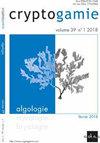标题塞尔维亚盐沼一新种(硅藻科,硅藻门)
IF 1.5
4区 生物学
Q3 MARINE & FRESHWATER BIOLOGY
引用次数: 0
摘要
摘要在塞尔维亚伏伊伏丁那省(Vojvodina)的碱水池塘和河道中发现了一新种Nitzschia haloserbica vidakoviki, Ector, C.E.Wetzel & krizmaniki, sp. nov.。2019年,在四个盐沼中发现了新物种:贝拉巴拉、Čoka Kopovo、Velika Rusanda和斯拉蒂纳。同样的物种四年前在匈牙利的盐湖中被记录,但作者将其列为Nitzschia sp. 2。Nitzschia Hassall新种的s形瓣轮廓与N. austaca Hust相似。但纹密度和腓骨分布不同。在N. haloserbica sp. 11 .中,跨根尖条纹非常密集,在光学显微镜下看不见。这两个物种都有沿中缝沟道规律分布的小管,但在奥地利白麻中,中间的两个小管间隔更宽,反映了中缝末端的存在,而在11月黑麻中则没有。在模式区域(贝拉贝拉),这两个物种的相对丰度分别为94.93%和1.21%(每片400个瓣)。讨论了新种的瓣形态、超微结构和解剖学特征,并与形态相似的分类群进行了比较。本文章由计算机程序翻译,如有差异,请以英文原文为准。
A New Nitzschia Hassall Species (Bacillariaceae, Bacillariophyta) from Saline Ponds in Serbia
ABSTRACT In the present study, a new species, Nitzschia haloserbica Vidaković, Ector, C.E.Wetzel & Krizmanić, sp. nov., is described from alkaline saline ponds and channels from Vojvodina Province (Serbia). In 2019 the new species was found in four saline ponds: Bela Bara, Čoka Kopovo, Velika Rusanda and Slatina. The same species was recorded four years ago in saline lakes in Hungary, but the authors listed it as Nitzschia sp. 2. The sigmoid valve outline of the new Nitzschia Hassall species is similar to N. austriaca Hust. but differs in striae density and fibulae distribution. In N. haloserbica sp. nov. the transapical striae are so dense that they are not visible in light microscopy. Both species have fibulae that are quite regularly distributed along the raphe canal, but in N. austriaca the central two fibulae are more widely spaced, reflecting the presence of central raphe endings, which are absent in N. haloserbica sp. nov. At the type locality (Bela Bara) both species were found with relative abundances of 94.93 % for N. haloserbica sp. nov. and 1.21 % for N. austriaca (of the 400 valves counting per slide). The valve morphology, ultrastructure and autecology of the new species are discussed and compared with morphologically similar taxa.
求助全文
通过发布文献求助,成功后即可免费获取论文全文。
去求助
来源期刊

Cryptogamie Algologie
生物-海洋与淡水生物学
CiteScore
2.60
自引率
7.70%
发文量
11
审稿时长
>12 weeks
期刊介绍:
Cryptogamie is a fast-track and peer-reviewed journal of international scope publishing in English only. It accepts original papers and review articles on the taxonomy, biology and ecology of all cryptogams. An issue of Cryptogamie may be devoted to a single topic, under the responsibility of guest editor(s). All articles published in Cryptogamie are compliant with the different nomenclatural codes. A copyright assignment will be signed by the authors before publication.
Cryptogamie, Algologie accepts articles on systematics as well as ecology and evolution of any kind of algae (including Cyanobacteria).
 求助内容:
求助内容: 应助结果提醒方式:
应助结果提醒方式:


